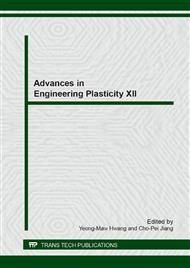p.62
p.68
p.74
p.81
p.85
p.91
p.97
p.103
p.109
Behavior Identification of a Multi-Layered Graded Stainless Steel Using an Inverse Method
Abstract:
The paper aimed at the behavior identification of a stainless steel sheet treated by surface mechanical attrition (SMAT). From tensile testing results on specimen after removing different depth of treated surface, a multi-layered model can be built. Therefore, the SMAT treated sheet is divided into five layers along thickness direction: the top and bottom hard layers of 0.15mm, the soft middle layer of 0.5mm, and two medium layers of 0.1mm in between. An elastic-plastic damageable constitutive model is adopted to describe the behavior of each layer. The parameters for each layer are identified using an inverse calculation technique. The three-dimensional ABAQUS/Explicit models with mass scaling are built for the SMAT treated tensile specimen with and without removed external harder layer. The best fit of parameters for each layer is obtained by minimizing the scatter between measured stress and calculated stress for the prescribed strain history. Finally, the identified material model is validated by the numerical simulation of a penetration test of SMAT treated sheet metal.
Info:
Periodical:
Pages:
85-90
Citation:
Online since:
August 2014
Authors:
Price:
Сopyright:
© 2015 Trans Tech Publications Ltd. All Rights Reserved
Share:
Citation:


